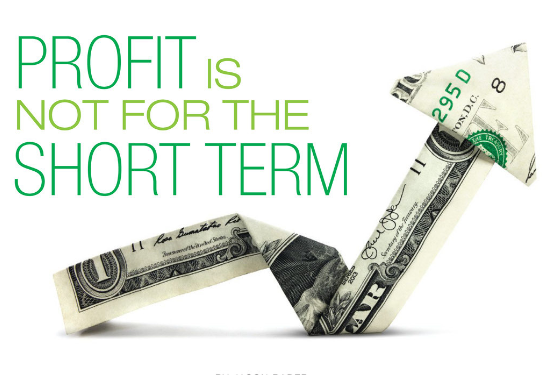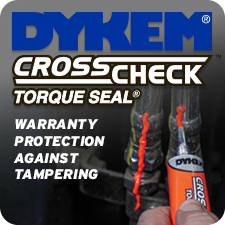Profit is not for the short term
by Jason Bader
As many of you who have been following my work know, I am a profit-driven advisor. Sales is for vanity, but profit is for sanity. I love to help drive this mentality in the clients, audiences and readers I serve. I recently made a breakthrough with a long-standing client that is on pace to achieve record net profit this fiscal year. Although I don’t think this client will fall into this trap, I am seeing indications where the quest for higher net profit percentages is moving some distributors toward short-term thinking.
The intoxication with seeing that net profit bulge at the end of the month can be very addictive. I love seeing this happen with the clients I serve; but not at the detriment of long-term growth or sustainability. Growth is imperative. I recently presented a webinar where the reasoning for growth was challenged. Why do we always have to grow? Isn’t maintaining a comfortable level of profitable revenue something we should aspire to? My simple answer was, “You only coast one way.”
A few months ago, I was having a discussion with another client about this growth versus profit conundrum. The company is currently enjoying a period of substantial growth. This growth is requiring additional investments in personnel, vehicles, technology and inventory. These investments are causing a dip in the monthly net profit they were enjoying last year. Since my client’s personal compensation is based on monthly net profit, he is concerned about a diminishing paycheck. Working harder and getting paid less is something most of us would be hard pressed to sign up for.
As a result of this reduction in income, the client is falling into some very short-term decision-making patterns. And, he is not alone. The owner of the business has become concerned with the inventory levels on hand. He has a magic number in his head, in dollars, of inventory that they should be carrying. Unfortunately, this number is based on a sales number from several years ago.
Investments in personnel have been falling off. The company is no longer actively recruiting to fill the personnel pipeline. Delivery vehicles are not being maintained at regular intervals and new ones don’t seem to have the durability of other options in the market. I am seeing a reluctance to invest in training opportunities and there has been little interest in new products or services. Fortunately, there have been some substantial technology investments that will help them long term. With the exception of technology, you can see how this reluctance to increase operating expenses is creating a perfect storm. Recently, the storm blew in.
Running a thin staff will test the mettle of any organization. Yes, we have great people who will rise to the occasion, but there is ultimately a breaking point. Mistakes compound. Tempers flare. Fingers start pointing. Eventually, stressed-out people start pondering the greenness of other pastures. In this case, 20 percent of the staff has left the company in the last 60 days. Some were planned or due to benign circumstances, but I believe that a majority of the people were simply sick of the toxic environment. By the way, that last description came directly from a former employee.
Adding to some of the discontent, especially in the sales staff, is the lack of inventory in the most critical SKUs. The reluctance to make these investments is forcing them to substitute, and source, products that carry a significantly smaller margin. When compensation is based on margin, sales commissions drop. Furthering the frustration is the inability to maintain a delivery schedule due to vehicle breakdowns. Customers are not receiving product when promised and the sales team is being dragged in to back up the delivery requirements. It is very expensive to allocate selling time to delivery services. As you can imagine, the quicksand is spreading.
This was a relatively preventable situation. Granted, it is easy to see what happened from a distance. Sometimes, when you are in the thick of the forest, it is difficult to see the trees. One of the first mistakes has to do with compensation. Too much of the overall compensation is tied to the monthly net profit. The decision maker, and to some degree the owner, were too focused on this number. Understand, I am not advocating that you take your eye off the net profit. That can be equally foolish. Once again, we find ourselves looking for that ideal state of balance – net profitable growth.
I was discussing this challenge with my younger brother who happens to own a very successful distribution company. Once you get rid of the familial dead weight, I guess you can really fly high; but I digress. He shared his thoughts about making investments for the long term. The real test of a company is how it manages the investment period. There will always be reductions in the bottom line as infrastructure is built. Ideally, you want to get that return on investment as soon as possible and return to solid net profit returns. If you want to build a sustainable organization, with manageable growth, you must get comfortable with this investment period. That is the cycle of business.
Two critical areas of investment would have prevented the scenario I described above. First, the company should have never taken their eyes off recruiting and retention. People are the lifeblood of any organization. Since most privately held distributors tend to promote from within, there must always be a pipeline of new warehouse and customer service staff coming into the building. I often drive clients to hire one extra person than they think they need. This is how we build a bench of promotable team members. Furthering the personnel investment, companies need to be consistent in their training efforts. Whether it is product knowledge, soft skills or technology utilization, employees need to be trained. If you think it is expensive to train your people, try not training them and see what that costs you.
The second key investment this company should have made was in inventory. Investments in inventory cost money. More often than not, we have to rely on a line of credit to finance adequate inventory levels. Lines of credit are not a bad thing and should never be feared. Think of them as a lifeline to customer satisfaction. Furthermore, the owner of the company needed to recognize that greater sales requires a greater level of inventory investment. There is a simple alignment tool that helps distribution owners find the right ratio of inventory dollars to sales revenue. It’s commonly referred to as inventory turn. I know a couple of people who can help with this one.
I don’t know how this company will weather the storm. I don’t think they are too far gone, but they are definitely taking on water. The key message here is balance. Seeing net profit grow each month is exciting and occasionally intoxicating, but let’s keep some perspective. Make sure that you are keeping up with internal investments required to meet your new revenue demands. Be patient with your returns and recognize that private company ownership is a marathon, not a sprint. Good luck and know that I am always here to help.
 Jason Bader is the principal of The Distribution Team. He is a wholistic distribution advisor who is passionate about helping business owners solve challenges, generate wealth and achieve personal goals. He can be reached at (503) 282-2333 or via email at Jason@Distributionteam.com or visit www.thedistributionteam.com.
Jason Bader is the principal of The Distribution Team. He is a wholistic distribution advisor who is passionate about helping business owners solve challenges, generate wealth and achieve personal goals. He can be reached at (503) 282-2333 or via email at Jason@Distributionteam.com or visit www.thedistributionteam.com.
This article originally appeared in the Sept./Oct. 2018 issue of Industrial Supply magazine. Copyright 2018, Direct Business Media.















